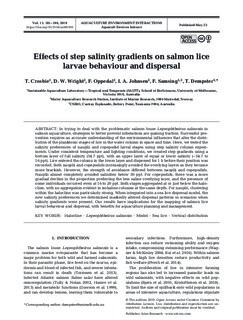| dc.contributor.author | Crosbie, Thomas | |
| dc.contributor.author | Wright, Daniel William | |
| dc.contributor.author | Oppedal, Frode | |
| dc.contributor.author | Johnsen, Ingrid Askeland | |
| dc.contributor.author | Samsing, Fransisca | |
| dc.contributor.author | Dempster, Timothy | |
| dc.date.accessioned | 2020-01-24T11:32:28Z | |
| dc.date.available | 2020-01-24T11:32:28Z | |
| dc.date.created | 2019-09-26T12:55:51Z | |
| dc.date.issued | 2019 | |
| dc.identifier.citation | Aquaculture Environment Interactions. 2019, 11 181-190. | |
| dc.identifier.issn | 1869-215X | |
| dc.identifier.uri | http://hdl.handle.net/11250/2637815 | |
| dc.description.abstract | In trying to deal with the problematic salmon louse Lepeophtheirus salmonis in salmon aquaculture, strategies to better prevent infestations are gaining traction. Successful prevention requires an accurate understanding of the environmental influences that alter the distribution of the planktonic stages of lice in the water column in space and time. Here, we tested the salinity preferences of nauplii and copepodid larval stages using step salinity column experiments. Under consistent temperature and lighting conditions, we created step gradients using a bottom layer of full salinity (34.7 ppt), with an upper layer of equal or lower salinity (~34.7 to 16 ppt). Lice entered the column in the lower layer and dispersed for 1 h before their position was recorded. Both nauplii and copepodids increasingly avoided the overlying layers as they became more brackish. However, the strength of avoidance differed between nauplii and copepodids. Nauplii almost completely avoided salinities below 30 ppt. For copepodids, there was a more gradual decline in the proportion preferring the less saline overlying layer, and the presence of some individuals occurred even at 16 to 20 ppt. Both stages aggregated at or just below the halocline, with no aggregation evident in isohaline columns at the same depth. For nauplii, clustering within the halocline was particularly strong. When integrated into a sea lice dispersal model, the new salinity preferences we determined markedly altered dispersal patterns in scenarios when salinity gradients were present. Our results have implications for the mapping of salmon lice larval behaviour and dispersal, with benefits for aquaculture planning and management. | |
| dc.description.abstract | Effects of step salinity gradients on salmon lice larvae behaviour and dispersal | |
| dc.language.iso | eng | |
| dc.title | Effects of step salinity gradients on salmon lice larvae behaviour and dispersal | |
| dc.type | Peer reviewed | |
| dc.type | Journal article | |
| dc.description.version | publishedVersion | |
| dc.source.pagenumber | 181-190 | |
| dc.source.volume | 11 | |
| dc.source.journal | Aquaculture Environment Interactions | |
| dc.identifier.doi | 10.3354/aei00303 | |
| dc.identifier.cristin | 1729534 | |
| dc.relation.project | Fiskeri- og havbruksnæringens forskningsfond: 14880 | |
| dc.relation.project | Norges forskningsråd: 244439 | |
| cristin.unitcode | 7431,14,0,0 | |
| cristin.unitcode | 7431,20,0,0 | |
| cristin.unitname | Dyrevelferd | |
| cristin.unitname | Oseanografi og klima | |
| cristin.ispublished | true | |
| cristin.fulltext | original | |
| cristin.qualitycode | 1 | |
